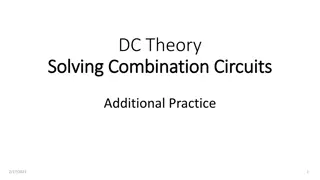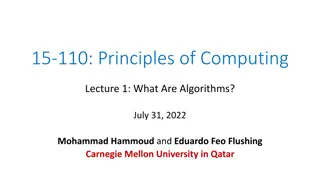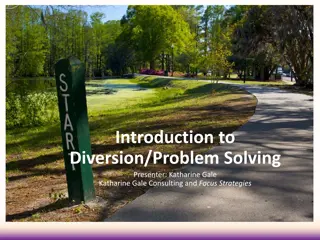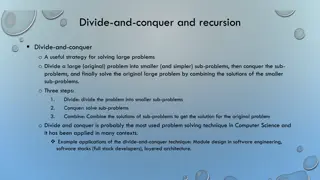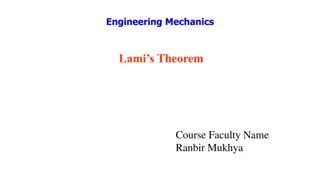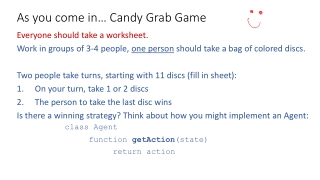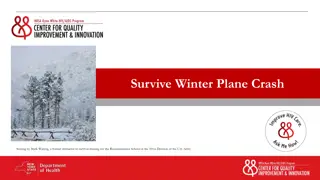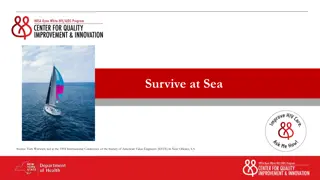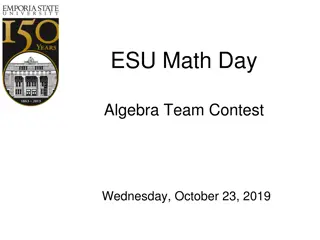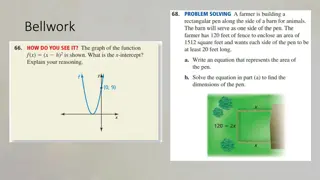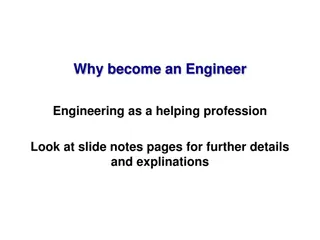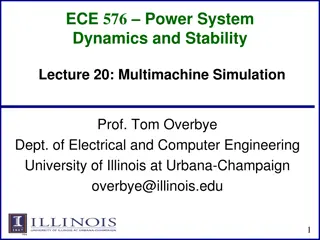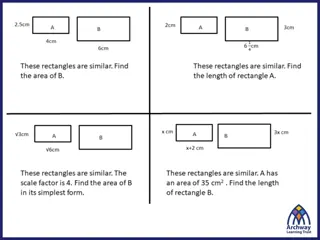Engineering Dynamics Principles and Problem Solving
Understanding the laws of motion and their application in dynamics is crucial in engineering. This content explains the concepts of force, acceleration, and inertia through practical examples such as projectile motion and frictional forces on a baggage truck. It also demonstrates how to calculate maximum heights, velocities, and forces in different scenarios. By exploring these principles, students can enhance their problem-solving skills in the field of engineering dynamics.
Download Presentation

Please find below an Image/Link to download the presentation.
The content on the website is provided AS IS for your information and personal use only. It may not be sold, licensed, or shared on other websites without obtaining consent from the author. Download presentation by click this link. If you encounter any issues during the download, it is possible that the publisher has removed the file from their server.
E N D
Presentation Transcript
University of Salahadden-Erbil School of Engineering Electrical Department fourth Year- seventh Semester 2018-2019 Dynamics By Asst. Lect. Niyaz O. Ali niyaz1969@gmail.com 1
Kinetics of a particles :Force and Acceleration First Law: A particle originally at rest, or moving in a straight line with a constant velocity, will remain in this state provided the particle is not subjected to an unbalanced force. Second Law: A particle acted upon by an unbalanced force F experiences an acceleration a that has the same direction as the force and a magnitude that is directly proportional to the force . Third Law: The mutual forces of action and reaction between two particles are equal, opposite, and collinear The first and third laws were used extensively in developing the concepts of statics. Although these laws are also considered in dynamics, it is Newton s second law of motion that forms the basis for most of this lecture , since this law relates the accelerated motion of a particle to the forces that act on it That is ? = ?? if a known unbalanced force F is applied to a particle, the acceleration a of the particle may be measured. Since the force and acceleration are directly proportional, the constant of proportionality, m , may be determined from the ratio m = F/a .The positive scalar m is called the mass of the particle. Being constant during any acceleration, m provides a quantitative measure of the resistance of the particle to a change in its velocity 2
EX(1): A 10-kg projectile is fired vertically upward from the ground, with an initial velocity of 50 m/s. Determine the maximum height to which it will travel if (a) atmospheric resistance is neglected.(b) atmospheric resistance is measured as FD = (0.01v ) N. where v is the speed of the projectile at any instant, measured in m/s. Solution: (a) ??= ??? (10) 9.81 = 10?? ??=9.81 m/s ?? 2= ?? 2+ 2??(?? ??) 0=(50) +2(-9.81)(??-0) ??= 127m (b) ??= ??? 10 9.81 0.01v = 10?? ??= 9.81 + 0.001?2 ???? = ??? 9.81 + 0.001?2?? = ??? ??? 9.81+0.001?2 0 ??= 500ln ?2+ 9810 |50 ??? ???? = 50 0 ?? = 9.81+0.001?2 0 ??=114m/s NOTE: The answer indicates a lower elevation than that obtained in part (a) due to atmospheric resistance. 3
Ex(2):The baggage truck A shown in the photo has a weight of 900 lb and tows a 550-lb cart B and a 325-lb cart C. For a short time the driving frictional force developed at the wheels of the truck is FA = (40t) lb, where t in seconds. If the truck starts from rest, determine its speed in 2 seconds. Also, what is the horizontal force acting on the coupling between the truck and cart B at this instant? Neglect the size of the truck and carts. Solution: ??= ??? 40t = (900 + 550 + 325 )?? 32.2 ??= 0.7256(t) ft/s 2 0.7256? ?? ? ?? = 0 0 2= 14.5 ??/? ? = 0.3628?2|0 900 32.2 ??= ??? 40 2 ? = 0.7256 2 T=39.4 Ib 4
Ex: The 100-kg block A shown is released from rest. If the masses of the pulleys and the cord are neglected, determine the velocity of the 20-kg block B in 2 s. Solution: Block A ??= ??? 100 9.81 2? = 100?? . The same way for block B ??= ??? 20 9.81 ? = 10?? T T 2??+ ??= ? 2??= ?? .. From the three equations above (**) it is found T=327N , ??=3.27m/s , ??= 6.54?/? ???= ??? + aBt ???= 0+ [ 6.54 2 ] = 13.08 m/s 100(9.81) A 20(9.81) B 5
EX (1):The 50-kg crate shown in Fig. rests on a horizontal surface for which the coefficient of kinetic friction is ??= 0.3. If the crate is subjected to a 400-N towing force as shown, determine the velocity of the crate in 3 s starting from rest. Solution: ??= ??? 400cos 30 0.3 Nc = 50?? ??= ??? 400??? 30 + Nc 50 9.81 = 0 ??=290.5 N ??=5.19 ??= ??+ ?? = o + 5.19 3 = 15.56m s 6
EX: the casting has a mass of 3 Mg. Suspended in a vertical A position and initially at rest, it is given an upward speed of B C 200 mm in 0.3 s using a crane hook. Determine the tension in cables AC and AB during this time interval if the acceleration is constant and angle BAC=60 and AC+AB. solution: ??= ??+ ?? o.2= 0 + ?(0.3) A=0.667m/s ??= ?? 2???cos 300 3000 9.81 = 3000(0.667) ???= ???= 18146.1 ? the tension in cables AC and AB 7
EX(2)The 160-Mg train travels with a speed of 80km/h when it starts to climb the slope. If the engine exerts a traction force F of 1/20 of the weight of the train and the rolling 1 resistance is equal to 1/500 of the weight of the train, determine the deceleration of the train. 10 Solution ??= ?? 160000(9.81)(1 1 1 101) = 160000? 20) 160000(9.81)( 500) 160000(9.81)( a= -0.5057m/s 8
Ex(3):The 160-Mg train starts from rest and begins to climb the slope as shown. If the engine exerts a traction force F of 1/8 of the weight of the train, determine the speed of the train when it has traveled up the slope a distance of 1 km. Neglect rolling resistance. Solution 1 ??= ?? 160000(9.81)(1 1 101) = 160000? 8) 160000(9.81)( 10 a= 0.25m/s ? ?=? ?+ 2a(?? ??) ? ?=0 + 2(0.25)(1000 0) ??=22.4m/s 9





